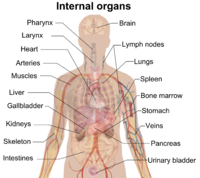
Photo from wikipedia
According to isotopic labeling experiments, most of the carbon used by truffle (Tuber sp.) fruiting bodies to develop underground is provided by host trees, suggesting that trees and truffles are… Click to show full abstract
According to isotopic labeling experiments, most of the carbon used by truffle (Tuber sp.) fruiting bodies to develop underground is provided by host trees, suggesting that trees and truffles are physically connected. However, such physical link between trees and truffle fruiting bodies has never been observed. We discovered fruiting bodies of Tuber aestivum adhering to the walls of a belowground quarry and we took advantage of this unique situation to analyze the physical structure that supported these fruiting bodies in the open air. Observation of transversal sections of the attachment structure indicated that it was organized in ducts made of gleba-like tissue and connected to a network of hyphae traveling across soil particles. Only one mating type was detected by PCR in the gleba and in the attachment structure, suggesting that these two organs are from maternal origin, leaving open the question of the location of the opposite paternal mating type.
Journal Title: Mycorrhiza
Year Published: 2019
Link to full text (if available)
Share on Social Media: Sign Up to like & get
recommendations!